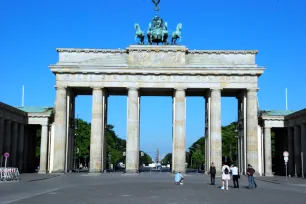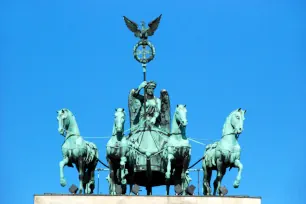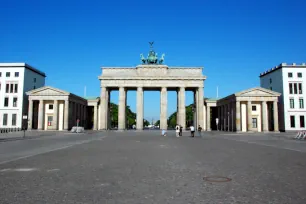The Brandenburg Gate, a monumental gate built in the eighteenth century as a symbol of peace, is Berlin’s most famous landmark. During the Cold War, when the gate was located right near the border between East and West Berlin, it became a symbol of a divided city.

But when the Berlin Wall fell in 1989, the Brandenburg Gate instantly became the symbol of a reunified Berlin.
The Brandenburg Gate is situated at the end of Unter den Linden, a grand boulevard that cuts through the center of Berlin. The gate was originally part of a wall surrounding Berlin and was the main entrance to the city. It is the only gate that remains of this former city wall.
Construction
The monumental gate was commissioned by Emperor William II as the replacement of an older gate. Architect Carl Gotthard Langhans based his design of the new gate, which measures 65.5 meters wide and 28 meters tall (213 x 92 ft.), on the Propylaea, the gateway to the Acropolis in Athens. The gate was named Friedenstor (Peace Gate) since it was meant to symbolize a period of peace after years of war during the reign of Frederick the Great.
Construction of the Brandenburg Gate started in 1778, and it officially opened in 1791. The decorations, including bas-relief scenes depicting Greek mythology, took another four years to complete.
The gate has five passages. The central and widest one was reserved for the royals; the adjacent passages were for the use of the aristocracy, while ordinary citizens were only allowed to use the outer two.
The Quadriga

The bronze quadriga of victory crowning the gate was created in 1793 by Johann Gottfried Schadow. The four-horse chariot is driven by the winged goddess of peace.
In 1806, when Berlin was occupied by French troops, Napoleon ordered the quadriga to be taken to Paris. After Napoleon’s defeat at the Battle of Waterloo, the quadriga was triumphantly taken back to Berlin, and was turned into a symbol of victory: an iron cross and eagle were added to the laurel wreath. At the same time, the square near the gate was renamed Pariser Platz and the statue on the quadriga was now called Victoria, after the Roman goddess of victory.
After WWII
The Brandenburg Gate, which had become a symbol of Prussian militarism, was badly damaged during World War II. After the division of Berlin between the allied powers, it ended up in the Russian sector, right near the border with the British sector.
The gate was repaired in 1956-1958 by East Berlin and West Berlin funded the reconstruction of the destroyed quadriga, which was created from the original mold. The iron cross and eagle, symbols of Prussia, were removed by the Communist regime, but they were added again after reunification.

Berlin Wall
On August 14, 1961, one day after the construction of the Berlin Wall, the Brandenburg Gate closed. Pariser Platz was now a desolate wasteland, and the gate became to symbolize the division of Berlin and Germany.
When the Wall finally fell in November 1989, people flocked to the Brandenburg Gate to celebrate. The gate, which reopened in December that year, was thoroughly renovated in 2000-2002 and now stands as a symbol of a reunited Germany. Meanwhile, Pariser Platz has completely been redeveloped and regained much of its nineteenth-century grandeur.
- Next: Reichstag
- More Sights & Attractions in Berlin
